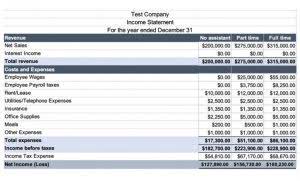
Without clear audit trails or system logs, validating expense categorization or proving policy compliance becomes difficult, increasing financial and reputational risk. Invoices that are not linked to a purchase order require more manual effort and judgment. These often include ad hoc services, professional fees, reimbursements, or one-time purchases, where no PO exists to guide the coding.
- Coding and classifying invoices means assigning them to the appropriate accounts, categories, and cost centers in the accounting system.
- Discrepancy identification is crucial for catching potential payment errors before they occur.
- Our web-based EDI software automates backups, eliminates the hassle of updates, and integrates with your accounting software.
- Many solutions offer bulk upload options or can automatically capture invoices from designated email addresses.
- Every company uses some form of each of these steps, even if the workflow isn’t completely formalized.
- Credit the cash sub-account (for a specific bank account) for the amount paid and code any early payment discounts earned as a credit to the discounts account.
Ultimate Guide to Coding Invoices: Process and Solutions

GL codes are highly organized systems, sorting each what is invoice coding spend category and subcategories depending on the highest order value of the code. GL coding all transactions correctly allows for a smooth accounting close, compliant processes, a complete view of your spending, and protection against fraud. Many companies manually assign GL codes to invoices, which is a highly error-prone and time-consuming process.
- Accounts payable and receivable folks can make music with their 10-keys, they are so practiced.
- It would lead to improper budget allocation and non-budgeted and unaccounted expenses.
- Collecting all of the bills and invoices can be a hard process to streamline, and getting visibility into everything that needs to be paid can be a real challenge.
- Interim invoices are issued when a large project is billed across multiple payments, and are sent to customers as progress payments against a project come due.
- GL code number are all assigned by a business, although many accounting software applications include a default chart of accounts that businesses can use.
- Automated batch payment processing is commonly used in accounts payable departments in businesses and organisations to streamline the payment process and improve efficiency.
Order to Cash Solution

Train your AP team thoroughly, emphasizing exception handling and correction procedures. Start with a pilot run using a subset of invoices, gradually increasing volume as you gain confidence. This guide will walk you through the process of invoice coding, how to automate it, and the best practices. By eliminating tedious manual processes, automation lets you reassign AP employees to higher-value tasks. After coding the invoice, the AP team records the invoice, the PO if present, the assigned GL code, and any notes or communication for future reference and to keep a complete audit trail.

Step 3: Invoice approval and payment

Enjoy the ease of keyboard-driven navigation, minimizing unnecessary clicks and maximizing your workspace efficiency. By integrating directly with your accounting system, Centime not only simplifies your processes but also provides invaluable real-time financial insights. If you are looking to streamline and simplify your AP process, Centime’s invoice coding automation is a game-changer. While top assets = liabilities + equity performers in an accounts payable department might memorize the list, it often takes a long time for new members of the payable team to learn the system and become productive. Apart from medical coding, which follows a highly complex set of standard codes, most companies have unique coding systems that depend on their specific business requirements.
Approval
- QuickBooks Online Invoicing Software allows you to create customised, professional-looking online invoices quickly so you’re able to get paid faster.
- Invoice coding is important because it helps maintain accurate financial records and allows companies to track expenses and revenue every month.
- Affinda’s invoice extractor is an automation software tool designed to automate the process of extracting data from bulk batches of invoices.
- By switching to an autonomous process, AP teams can save an incredible amount of time and redirect efforts toward more strategic work.
Small businesses, mid-sized companies, and enterprises each develop coding practices tailored to support their https://www.bookstime.com/ specific financial requirements. Match each line item to the correct general ledger (GL) account in the chart of accounts. For instance, toner cartridges might be coded to “Office Supplies Expense” (GL 6200), while a new printer could go to “Office Equipment” (GL 1500) as a fixed asset, not an expense. It brings structure to your data, supports meaningful analysis, and helps you stay compliant with accounting standards and tax regulations. Without standardized coding rules or system-enforced logic, different teams may apply different codes to similar transactions.

The primary benefit in batching accounts payable transactions is a reduction of entries in the accounting system. Companies with high numbers of low dollar value transactions can quickly see thousands of debits and credits in expense accounts. This level of detail in the payables ledger is unnecessary and creates a processing burden for the computerized accounting system. By batching transactions on a daily or weekly basis, this burden is alleviated. Shuffling paper invoices around desks and tracking them is a challenging process. Many paper invoices get lost in the mix or their processing may be delayed because of such inefficient manual processes..
For example, if you always use the same code for a certain vendor, create a rule that applies it automatically. Add conditional prompts to flag inconsistencies (e.g., a missing cost centre code), to reduce manual corrections. Efficient expense management is crucial for organizations aiming to maintain financial accuracy and operational efficiency.
